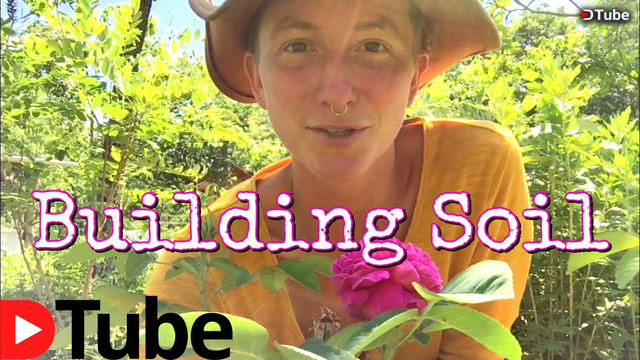
Since moving onto our Homestead, we have done our darndest to align ourselves with nature and work as closely as possible with the land we are now stewards of.
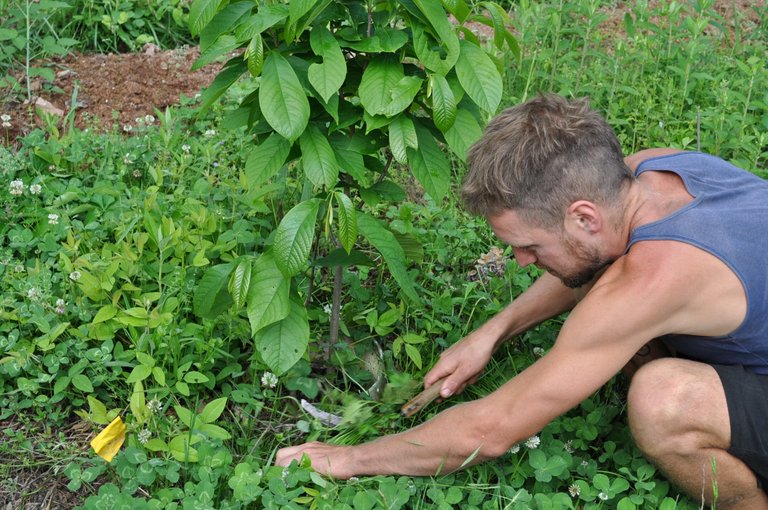
Ini practicing the Chop & Drop method beneath a native Paw Paw on our land using a Japanese Rice Knife.
Through years of study and hands-on experience on other properties, we had gleaned a fairly wide breadth of understanding of what Permaculture could look like.
We see Permaculture not strictly as a set of techniques, but rather as an ideology, approach and design modality. By striving to embody, practice and evolve our connection to the natural world, we have come to deeply appreciate the strategies of land management that are simple, slow and require less work from us.
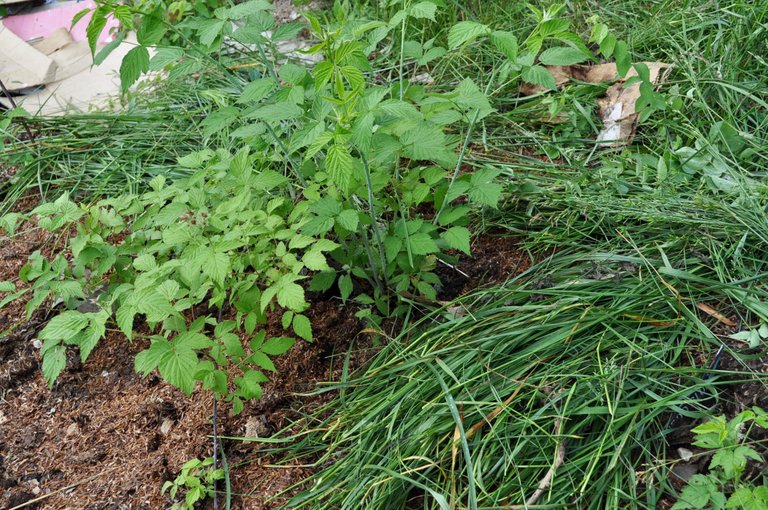
Grass chopped and dropped at the base of a Raspberry Plant.
Transitioning Land
We moved onto a property that had not been inhabited by humans, but which had a section that been cleared within the past decade.
Luckily the previous owners had a driveway put a driveway in, but we knew we had a lot ahead of us. We did an assessment of existing communities and ascertained an overall picture of the stage of ecological succession that the land was going through. We noted the diversity of species, growth habits, soil textures, slopes and other indicators of what kinds of plants the land would best support.
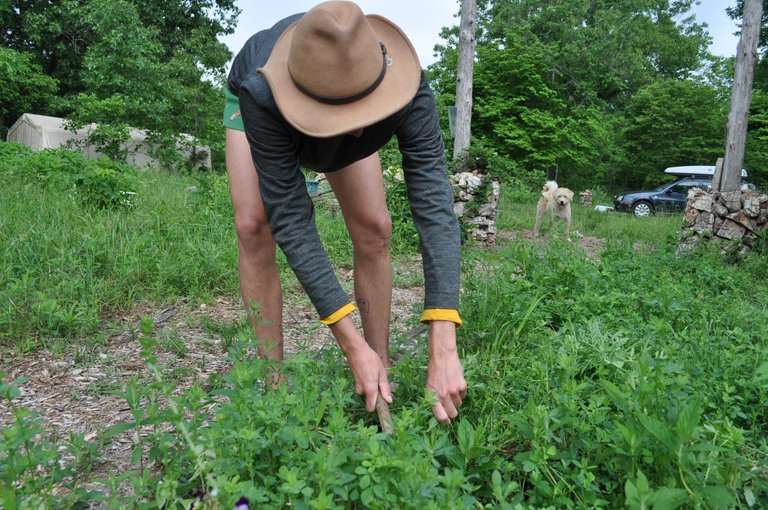
Wren cutting alfalfa cover crop (rich in nitrogen and nutrients) to drop in place to slowly build soil.
All of this informed the following stages of evolution that we are guiding on this gorgeous property we are blessed to steward.
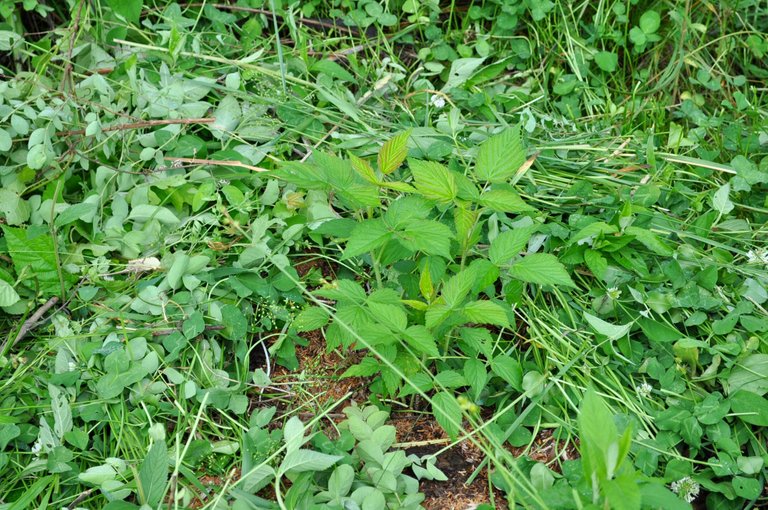
Another berry with organic matter at its base.
The process of clearing brush and saplings began, and before we knew it we had pathways cleared and a plan started to evolve. Soon enough we had hundreds of plants in the ground and needed to ensure these plants thrived.
Strategies for Thriving Plant Establishment
The first thing we were keen on was choosing appropriate species for the land. This meant learning about what already was growing here and going from there.
We noticed mulberries, persimmons, paw paws, blackberries, blueberries and grapes all growing wild on the land. We chose to focus on improved varieties or similar species to those already happily growing here. We have since planted and grafted a wide variety of similar species. Given our poor soils and low organic matter (not to mention a desire for abundance) we knew water and nutrients needed to be deeply considered and carefully managed.
Why not work with nature on this one?
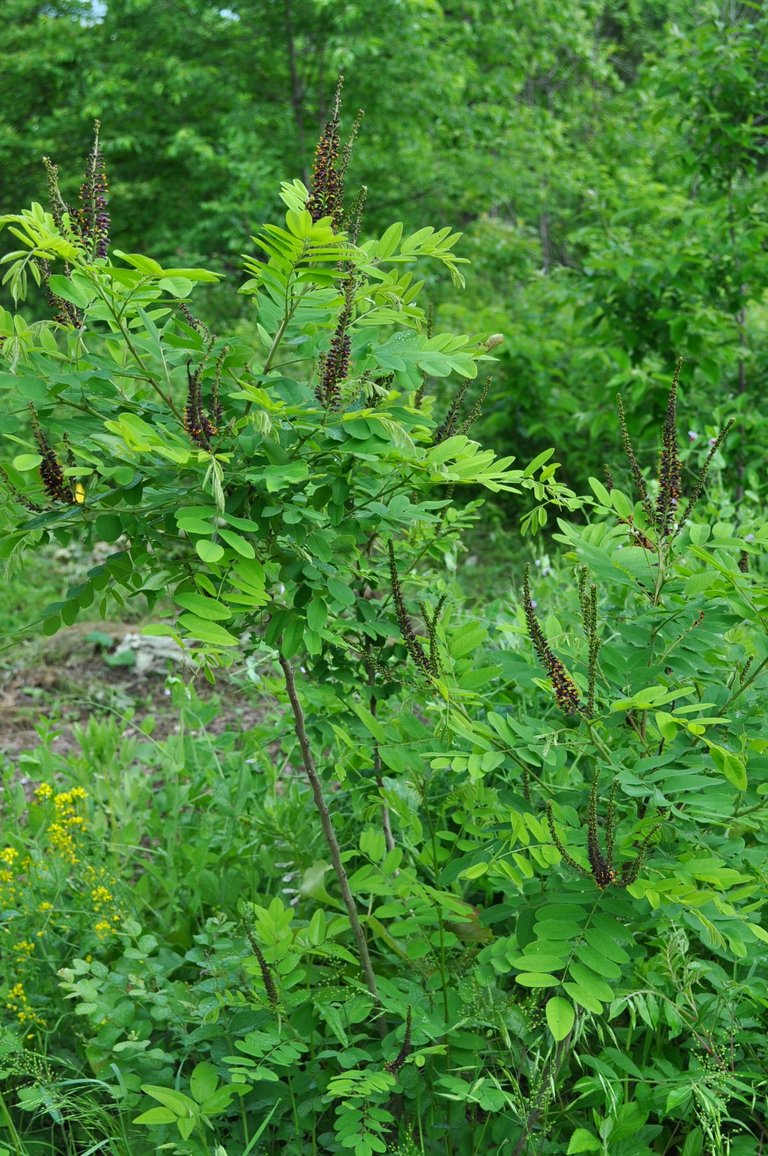
Wild False Indigo, a regional native plant that we introduced to our land. It is a legume which naturally "fixes" nitrogen into the soil while also providing beautiful blooms as a nectar source and copious amounts of organic matter each season that we prune and drop around nearby plants to build soil and mulch with.
Chop and Drop
During the several PDC (Permaculture Design Courses) I have either attended as a student or as a student teacher, the most impactful take home is the importance of OM. Yes the seed sound cosmic creation vibration root of all life embodiment of the universe…. but also organic matter.
Organic matter plays a vital role (and is under-appreciated in conventional agriculture) in the soil food web and overall health of plants. This is where the chop and drop technique shines.
Chop and Drop could not be a simpler technique as it uses plants growing near a “crop” plant as mulch.
At Mountain Jewel we employ this heavily as it is important to bolster the soil food web.
What this means for us is planting species that are known as dynamic accumulators (plants that act of pumps to liberate and accumulate minerals for plant use) such as comfrey, dandelion, chicory plantain and others.
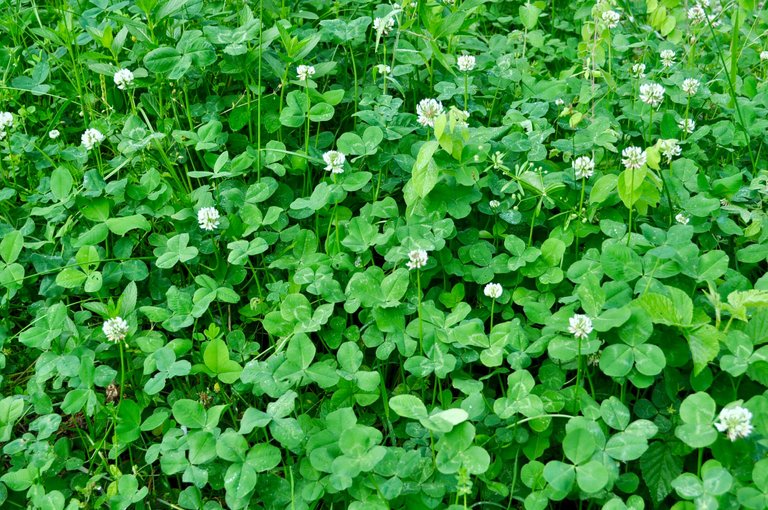
White clover we've seeded on the property as a cover crop which we chop and drop to build soil. A fantastic option!
We also have established healthy stands of red, white and crimson clover, which both fix nitrogen and create great mulch. It also means using existing species (mostly a variety of cool and warm season grasses, blackberries and buckbrush) as mulch. Both the planted and wild plants are cut low to the ground and piled around the plants we are choosing to crop. Here’s the gist of it:
- Chop (or cut)
- Drop
- Repeat
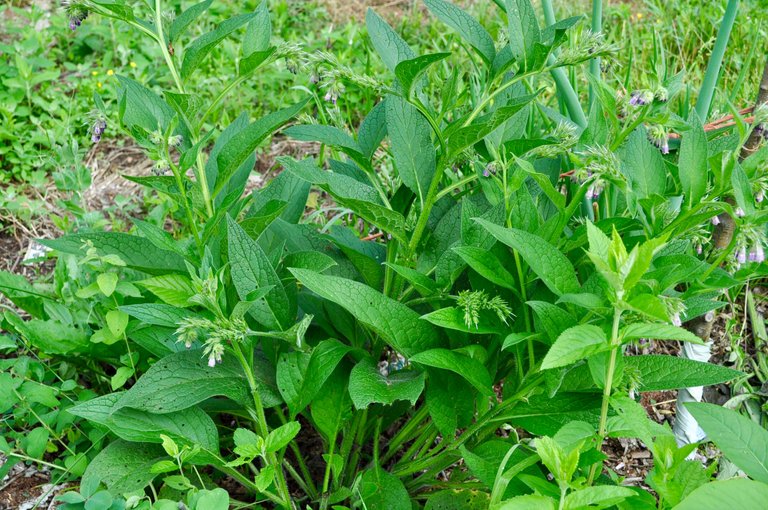
Comfrey, another must-have chop and drop plant in any garden. Comfrey brings up nutrients and minerals from the soil which are then collected in her leaves. Chopping and dropping around plants benefits them as her leaves decompose and add greatly to the soil food web. A fantastic plant!
Feed Your Soil to Feed Your Plants
This grassroots practice (you catch the pun ;)) has many benefits that are not immediately obvious, but some that are. For starters, it suppresses weeds. When mulch is laid of heavily enough, it blocks sunlight from reaching the soil; this in combination with a dense layer will smother most plants. If you’re dealing with enthusiastic plants like bindweed, quack grass, Johnson grass, Bermuda grass, sheep sorrel or others you may have to get a little cheekier.
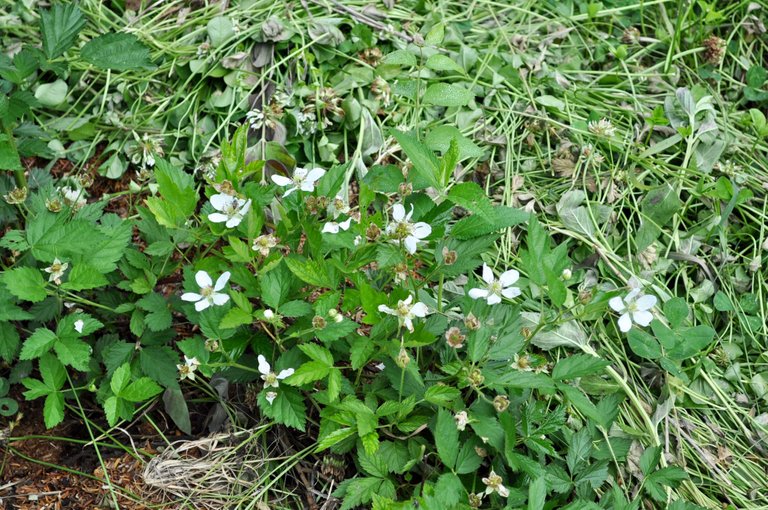
A Boysenberry with chop and dropped OM around it.
On the whole the continued application of heavy mulch will suppress unwanted plant growth around the plants you’re caring for.
In natural ecosystems, rarely is bare soil present. Nature abhors a vacuum and will quickly fill the bare soil with plants.
The obvious result from adding organic matter on top of soil is protection of the soil itself. By adding mulch, we are mimicking natural soil cover while protecting the microbes from the hot sun, regulating moisture and temperature while also mitigating erosion and structural damage to the soil.
The mulch will eventually become food for microbes and critters, which will improve soil quality in umpteen ways. The benefits of OM are astounding!
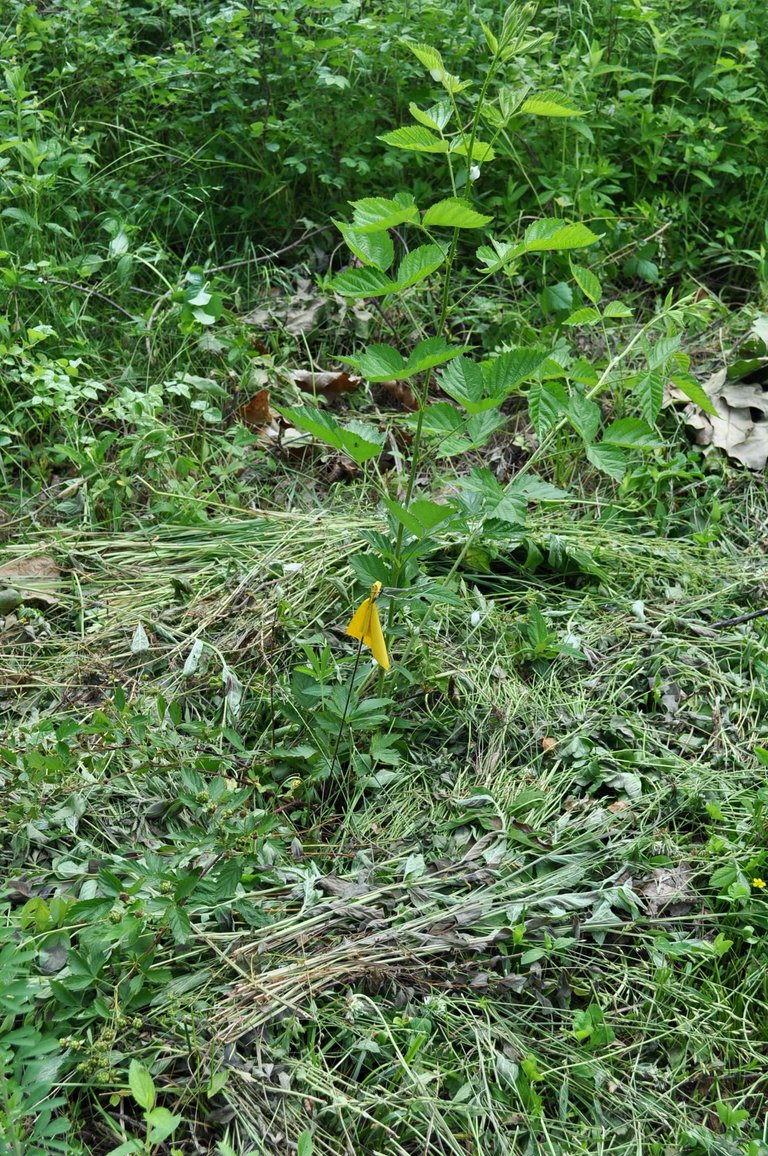
Another berry with Chop and dropped OM around it.
Using green fresh mulch will add nitrogen to the soil and help feed the plant as well. We especially favor white clover because it adds nitrogen (while growing and as mulch), of its low growth habit, honeybee forage and dense growth. We cut the clover every few weeks, which actually stimulates roots to grow bigger and stronger. They also set seed much more quickly than grasses so this repeated cutting can help tip the scales in favor of a clover land. The repeated cutting is similar to how grazing animals can improve pasture land by cyclically eating of the tops of plants causing some root die off but also stimulating growth and helping promote water infiltration, nutrient flows and increasing OM in soil.
Right Tools for the Job
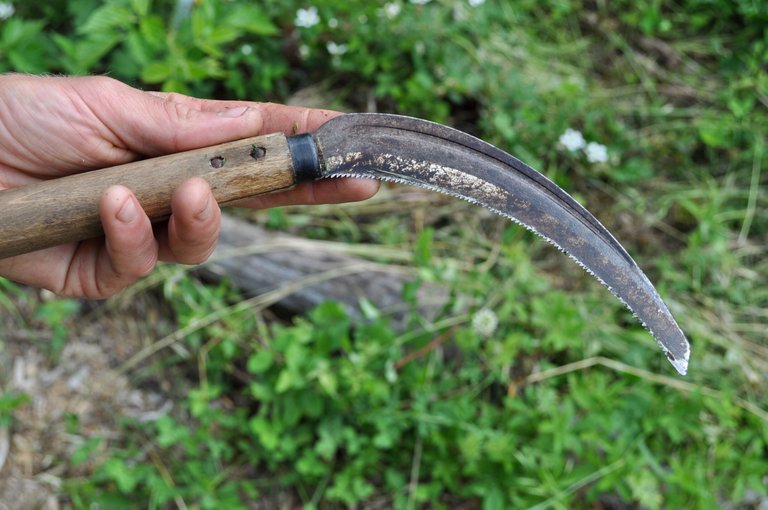
Japanese Rice Knife
The tools depend heavily on what kind of terrain and plants you’re dealing with.
Sometimes we will simple tear the clover with our hands, or pull out herbaceous plants. We may also use a brush scythe (I have 1000s of hours of practice cause it’s the exact motion used when playing hockey). Hands down the favorite tool for the job. It is a serrated sickle, introduced to me as a Japanese rice knife. A Japanese Permaculture group gifted this tool to me while visiting O.U.R. ecovillage when I was working there as farm manager. I am slightly biased in that I have loved every Japanese tool I’ve used.
I like using this tool as I can use it squatting or bending over and can cut very close to the grounds. It also is much less strenuous than swinging a brush scythe. If we had flatter land with fewer rocks and brush and more grass, I’m sure I would be all about the scythe. If you use any type of mower, the cut brush and grass can be added as mulch to plants as well.
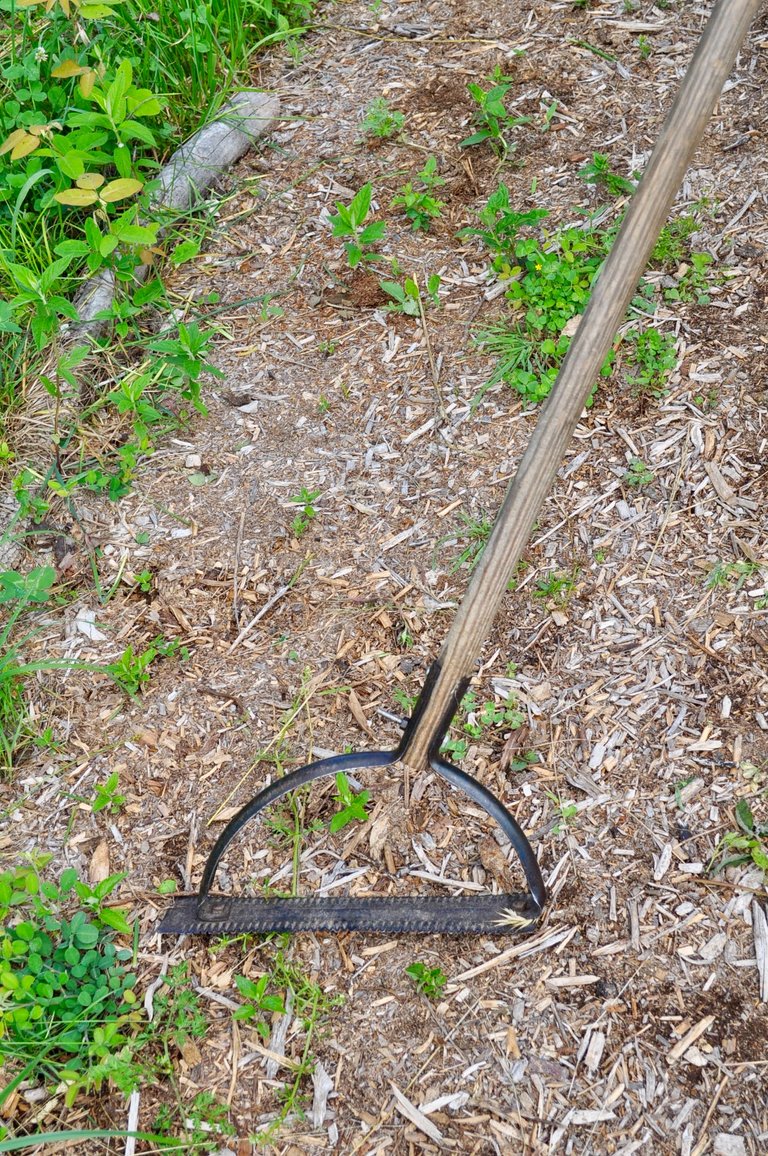
Brush Scythe
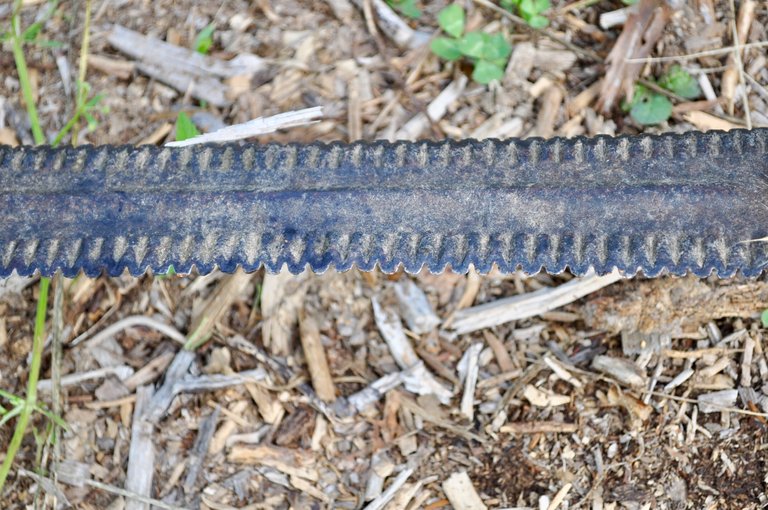
Brush Scythe detail.
As usual, these permaculture solutions are small/human scale, simple and effective, but they take time. Sometimes we let the weeds go too far and the grass reseeds itself. Sometimes we dream of more wood chip mulch (but have yet to find a great source). All in all, we love this method and it's so satisfying to see soil building up slowly over time like it does in nature. A well mulched plant is a thing of beauty.

Happily mulched Raspberry & Native Monarda
Long Live Chop & Drop! Get MULCHING!

banner by @radicalunicorn
▶️ DTube
▶️ IPFS
This was an incredible education. Thank you.
I am currently near a Native American permaculture farm run by a friend of mine’s non-profit. I’ve been wanting to go visit, but the back doesn’t let me go that far just yet. So I haven’t seen what I’m talking about, but she tells me they are using traditional farming methods of this area there. This really hit me when she said it because I realized that I had unconsciously been associated all permaculture with what has been a part of that movement here in the US. There is of course permaculture wisdom all over the world, whether it is called that or not. All traditional farming was permaculture, wasn’t it?
so happy to hear this was helpful to you! <3 so cool. is it outside of Santa Fe? I visited a couple in that area, especially near the Pueblo in Taos which has some radical things going on. I know that the traditional farming methods of many Native Americans in the desert southwest call for such drastically different methods (like burying corn really deep in the soil) than in our area, for example, because of the low rainfall (9 inches a year), high heat, strong winds, etc. I was going to mention in a previous comment I was making to you about the acequias in that area that humans dug a long time ago. They may be of interest to you to visit when you're feeling like moving around. They're basically water channels from the snowy mountains that run all the way to the fields. It gets very political (as do water rights in any area where it's scarce), but so so incredible to see the snow melt water flowing in the spring and channeled throughout so many people's fields using an ancient system. Taos has them extensively and if you want to meet some other people growing food and doing good work there in that regard, I'm happy to introduce you!
Yes yes yes!!! this is such a great point and one that so many people who "get into" permaculture slowly start to realize. Permaculture is just a recent repackaging of ancient traditions. Certainly humans have specifically place-based ways of relating to their specific climates and lands everywhere. I'm not sure that all traditional farming is relating to the essence of permaculture as in permanent + culture just because of serfdom and humans having this common problem of "over-using" or exploiting resources for capital gain without tending for them, but yes a lot of cultures around the world practice highly evolved and adapted forms of permaculture, which they probably just think of as gardening haha!
i'll be interested to hear more of what your friend is up to if/when you get a chance to visit. i hope your back keeps feeling better and better <3 !
I would love intros to folks in Taos area doing permaculture based on the needs of this location. I’ll be there in a couple days. My friend’s place is in a poor town called something like Espanola.
priceless information!!!! chop and..... DRRRROP!!!!!!! that land sings!!!!!! the paw paw!!!!!! please keep it coming ya'll!!!!!! thank you!
:))))) the land and the birds are singing this morn!! <3 thank you for your constant enthusiasm and passion!! and thanks for the resteem! <3
Green manure is the green gold 😃
Great post & farm
yes it is!! thanks so much <3
One of the best things about joining Steemit was discovering this world of permaculture and food forests. It has changed my whole approach, instead of digging meticulous rows and aiming for a fine tilth, I just find a space about the right size and work on top of it, chopping down, adding compost and organic matter and planting what I would like to grow there. I've just realised this afternoon I've collected a pile of potential mulch! It is so much more fun and much more accessible for urban dwellers like me who want try things a little differently. Not everything will work (not enough observation yet), but I have been inspired to do something and see what happens.
i'm so happy to hear this!!! wow, this really inspires me to keep sharing here!! thanks for your reflections; i'm so happy to hear about your shift and healthy garden experimentation :) it's so great when we can have open enough minds to try different methods that are more aligned with natural rhythms. bring on the abundance. many thanks!
Apart from anything else, it is just so much fun. This afternoon I felt like I was playing in the garden, rather than working. Of course, it is so good healthwise to be outside and Active, but the additional element of play and creativity has made it a fabulous afternoon. Please do keep sharing!
I really enjoyed this post. Thank you!
great to hear!! thanks! and thanks for the resteem :) <3
Very informative shame ivy in not as good as i've just cut a load down and its sitting in my yard waiting for a use 💯🐒
Hmm. Do you have any plans to mulch? You could always compost the ivy if no mulching options present themselves.
No where to mulch, see my last post, it has a picture of the yard its tiny. I want to compost but need a composter, it's just affording one your looking at over £100 for a bottom range one. I have plans to build one just finding the materials 💯🐒
Have at it! I'm sure you could find free material to build one out of. Shipping Pallets are great and usually free. Best of luck.
Yes I am on the look out for shipping pallets only for some at £15 a pop currently plus i'd have to pick them up somehow on my push bike haha not an easy task. Nothings is free currently here WHY? Some will come i'm sure 💯🐒
A Brush Scythe was called an idiot stick or more charitably a weed whacker when I was growing up. Yeah I spent sometime with one in my youth. I am interested in your post because we have a grassy hill in some common space near our house. In my part of California, they obsess about wild fires so they clear all the cover but then the area gets over run with weeds. In the past they would have hit the weeds with chemicals. Thankfully they don't do that but there needs to be a weed managements plan.
Glad you know of the brush scythe, great tool. I've seen what you're talking about. its tricky cause the weeds are most likely healing the damage incurred through clearing and are a response to disturbance. Management can be tricky... Goats are great at managing brush as long as they are contained;) Happy no more glyphosate is being sprayed, that stuff is no Bueno big time.
I love how you present information.
I 100% agree with Observation being key. I work with plants in many facets of healing, the growing things around us have so much knowledge to impart if we stop and listen.
Thanks for the feedback, well received. So right in the deep wisdom surrounding us. Pleased to hear you appreciate the green ones.
Great toutorial! Love the idea of building soil and being mindful of soil conservation!
Glad to hear you appreciate it. Building soul MUST take into mind conservation. It's such an important topic, that requires much public attention.
Ok...our yard is a mess, but we are always talking about cleaning it up and making better use of the space. once the neighbors trees cast too much shade for my veg beds, I just stopped! but your posts are just too much fun to ignore the urge to clean up! My skate date was ruined by rain, but it's not too much to get outside and start cleaning up some of the mess! thank you for your amazing posts. resteeming to keep the energy flowing!
Love it! Shade gardens are cetainly an option you may consider. Congrats on the new vigor for yard care. Thanks for all the great feedback, support and feedback.
What is this type of Brush Scythe?? The ones I've seen are like shorter and thicker scythe blades, but still a regular scythe with proper handle and corresponding movement. That one above looks a bit like push-pull hoe with a serrated edge? How do you work it?
Not sure of the details on this tool... I use it like a hockey stick. I swing it in front of me with hands slightly apart on the handle. I'd like to get my hands on one of the scythe shaped serrated ones, seems like a more effective tool. The serrated sickle gets more use as I use it around plants that haven't got their thick mulch yet.
Weekly Curation. Thank you for sharing your knowledge and experience with chop and drop soil improvement.This post has been featured in the @offgrid-online
Thanks for sharing the post, we appreciate it.
You are doing a great job @mountainjewel, I liked your article a lot, it is beautiful, beautiful pictures, take care of yourself, God bless you always.
Regards
Thanks @saracampero, happy you liked it. We appreciate your support.
Very good read!
We are shopping for a homestead soon. I hope to use things like "chop & drop", and wild harvesting once we are settled.
Thank you for sharing!
I'm drinking all this in. Itching to get started. Thanks for continuing to inspire me!